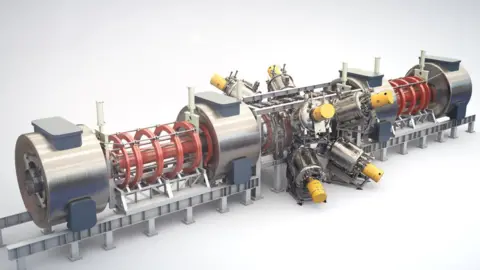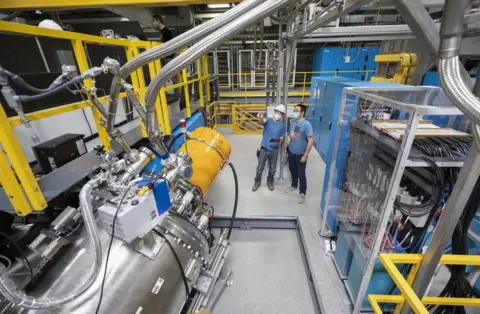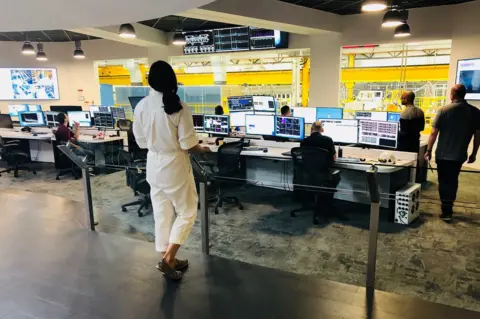Fusion race kicked into high gear by smart tech
 TAE Technologies
TAE TechnologiesA US company is speeding up the path to practical fusion energy by using Google's vast computing power.
By applying software that can improve on its own, TAE Technologies has cut down tasks that once took two months to just a few hours.
Google has lent the firm its expertise in "machine learning" in order to help accelerate the timeline for fusion.
Nuclear fusion promises a plentiful supply of low-carbon energy, using the same process that powers the Sun.
Existing nuclear power is based on fission, where a heavy chemical element is split to provide a lighter one. Nuclear fusion works by combining two light elements to make a heavier one.
For fusion to become economically-viable, it must first generate more energy than the amount being put in. But no one has yet reached this point, despite an eight-decade effort to "build a star on Earth". The challenges are immense, but some in the fusion community hope that new thinking and disruptive technologies could help shatter this paradigm.
"I want to deliver fusion first, but anyone who does it is a hero," TAE's chief executive Dr Michl Binderbauer told BBC News.
 TAE Technologies
TAE TechnologiesTAE, located in leafy Foothill Ranch, south-east of Los Angeles, has raised over $880m in private funding. High-profile backing has come from Goldman Sachs, the Rockefeller family and the late Paul Allen, co-founder of Microsoft. Its board of directors includes a former US Energy Secretary, Ernest Moniz.
The company's 30m (100ft) -long fusion cylinder - called C2W "Norman" after TAE's founder, physicist Norman Rostoker, who died in 2014 - represents a different approach to the doughnut-shaped "tokamak" to be used for the world's biggest fusion experiment, the multi-billion-euro ITER project.
By generating a hot, electrically-charged gas called plasma, the device enables fast-moving particles to fuse, releasing energy. But controlling plasma at tens of millions of degrees requires a finely-tuned system. Google's expertise in machine learning - where computer algorithms improve with experience - has been used for "optimising" TAE's fusion device.
Optimisation, or tuning for best performance, is carried out when something on the device changes, such as new hardware being added. This process once took around two months, but with machine learning, "we can now optimise in fractions of an afternoon," Dr Binderbauer explained.
 TAE Technologies
TAE Technologies"The way the rate of learning has accelerated is incredible and allows us to make changes much more readily." Machine learning is also used to reconstruct what's going on during a fusion experiment, or "shot". Multiple strands of data can be pulled together for a deeper understanding of the process.
"That's incredibly computer-dense and is a problem heretofore fairly few people even attempted to attack," the CEO explains. He says the results of the partnership with Google could shave a year from the company's longer-term schedule, which envisages a commercial fusion test device by 2030.
The company has already come a long way: Rostoker, a professor at University of California Irvine, founded it as Tri-Alpha Energy in 1998. Austrian-born Binderbauer was one of Rostoker's PhD students, and became the company's CEO four years ago. The two physicists chose TAE's approach by starting with the requirements for a fusion power plant and working backwards.
The $150m "Norman" device crashes together two balls of plasma at supersonic speeds inside the tube. Magnetic fields, in what's known as a Field-Reversed Configuration (FRC), are used to control the process - which happens in just 40 millionths of a second.
According to Prof Jeremy Chittenden, of Imperial College London, TAE is "doing something quite different to what everyone else is doing". Rather than relying on the heat of the plasma to generate fast-moving particles for fusion, the device uses external particle beams which are fired into the hot gas, similar to what happens in a particle accelerator. "That's your fusion source," he explains.
 TAE Technologies
TAE TechnologiesFusion efforts such as ITER will use fuel consisting of deuterium and tritium - two heavy versions of the element hydrogen. This produces energy from fusion at tens of millions of degrees C, which is still at a lower temperature than some other options. However, there are downsides: tritium is radioactive, wears down the insides of fusion reactors, and has a finite supply.
The "Norman" device powers its reactions with "regular" hydrogen and deuterium - a more benign, if less potent choice. But these are good surrogates for the fuel TAE eventually wants to move on to - hydrogen and boron. This produces no neutron particles and therefore little radioactivity, making machines straightforward to service and maintain. But this fuel also requires extremely high temperatures.
C2W "Norman" can operate up to 70 million degrees C, but hydrogen-boron fuel requires temperatures to rise by a factor of 20-30, to several billion degrees C. It's a major challenge: "Powers of ten are a big deal in science," says Binderbauer, "Can we get to hydrogen-boron? I'm very convinced we can."
 TAE Technologies
TAE TechnologiesProfessor Roddy Vann, a plasma physicist at the University of York, UK, who works on fusion with tokamaks, said: "Whilst you've got to get the temperature right, the temperature and the density and the energy confinement time all have to be sufficiently high, simultaneously."
While neutrons do produce some radioactivity in the tokamak structure, he explains, it's also their energy that we capture in "conventional" deuterium-tritium fusion. However, said Prof Vann: "If we could do aneutronic fusion, and could do it at temperatures that were achievable, that would be very interesting."
Prof Chittenden explained: "Because they're not doing this through heat, but through particle acceleration, that disadvantage of [hydrogen-boron fuel] drops away," adding: "The net gain through realising something as a commercial fusion plant is potentially huge, because a vast fraction of the cost of a deuterium-tritium plant is handling the radioactive products."
Dr Binderbauer says TAE's approach is also less susceptible to turbulence - which hampers the ability to control plasmas in tokamaks - and to energy leaking from the machine. In fact, the leak rate goes down as the temperature in the device goes up, he says. "As you get more energetic, the behaviour gets more manageable, more predictable, more reliable," he says.
Two reactors are being planned to follow "Norman" - Copernicus and Da Vinci. A key goal within a decade is to produce net energy, where the output from fusion exceeds the energy supplied to initiate reactions.
After nearly 25 years in existence, TAE has pioneered technology with applications beyond just fusion. It is refining a technique called boron neutron capture therapy with a view to its use in cancer treatment. And it has formed a new division to commercialise the power management systems from its work on C2W "Norman" for use in the electric car and energy storage sectors.
Follow Paul on Twitter.
